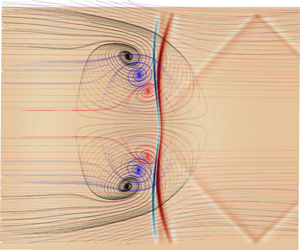Crossref Citations
This article has been cited by the following publications. This list is generated based on data provided by
Crossref.
Threadgill, James A. S.
Little, Jesse C.
and
Wernz, Stefan H.
2021.
Transitional Shock Boundary Layer Interactions on a Compression Ramp at Mach 4.
AIAA Journal,
Vol. 59,
Issue. 12,
p.
4824.
Lusher, David J.
Jammy, Satya P.
and
Sandham, Neil D.
2021.
OpenSBLI: Automated code-generation for heterogeneous computing architectures applied to compressible fluid dynamics on structured grids.
Computer Physics Communications,
Vol. 267,
Issue. ,
p.
108063.
Costantini, Marco
Henne, Ulrich
Klein, Christian
and
Miozzi, Massimo
2021.
Skin-Friction-Based Identification of the Critical Lines in a Transonic, High Reynolds Number Flow via Temperature-Sensitive Paint.
Sensors,
Vol. 21,
Issue. 15,
p.
5106.
Deshpande, Akshay S.
and
Poggie, Jonathan
2021.
Large-scale unsteadiness in a compression ramp flow confined by sidewalls.
Physical Review Fluids,
Vol. 6,
Issue. 2,
Liu, Xu
Zhang, Lingfeng
Ji, Yuan
He, Miaosheng
Liu, Yingzheng
and
Peng, Di
2022.
Fast PSP measurement of three-dimensional low-frequency unsteadiness in sidewall-confined shock wave/turbulent boundary layer interaction.
Experimental Thermal and Fluid Science,
Vol. 134,
Issue. ,
p.
110599.
Chang, Eric Won Keun
Chan, Wilson Y.K.
McIntyre, Timothy J.
and
Veeraragavan, Ananthanarayanan
2022.
Hypersonic shock impingement studies on a flat plate: flow separation of laminar boundary layers.
Journal of Fluid Mechanics,
Vol. 951,
Issue. ,
Zuo, Feng-Yuan
Memmolo, Antonio
and
Pirozzoli, Sergio
2023.
On wall pressure fluctuations in conical shock wave/turbulent boundary layer interaction.
Journal of Fluid Mechanics,
Vol. 967,
Issue. ,
Lusher, David J.
Zauner, Markus
Sansica, Andrea
and
Hashimoto, Atsushi
2023.
Automatic Code-Generation to Enable High-Fidelity Simulations of Multi-Block Airfoils on GPUs.
Gaitonde, Datta V.
and
Adler, Michael C.
2023.
Dynamics of Three-Dimensional Shock-Wave/Boundary-Layer Interactions.
Annual Review of Fluid Mechanics,
Vol. 55,
Issue. 1,
p.
291.
Zuo, Feng-Yuan
2023.
Hypersonic Conical Shock-Wave/Turbulent-Boundary-Layer Interaction at High Reynolds Number.
AIAA Journal,
Vol. 61,
Issue. 9,
p.
3743.
Grébert, Arnaud
Jamme, Stéphane
Joly, Laurent
and
Bodart, Julien
2023.
Microramp wake impinging on canonical shock/boundary-layer interaction.
Physics of Fluids,
Vol. 35,
Issue. 6,
Sabnis, Kshitij
and
Babinsky, Holger
2023.
A review of three-dimensional shock wave–boundary-layer interactions.
Progress in Aerospace Sciences,
Vol. 143,
Issue. ,
p.
100953.
Mangalagiri, Raja
and
Jammy, Satya P.
2023.
Sidewall effects in laminar ramp induced shockwave boundary layer interactions.
Computers & Fluids,
Vol. 267,
Issue. ,
p.
106063.
Zuo, Feng-Yuan
2023.
Hypersonic Shock Wave/Turbulent Boundary Layer Interaction over a Compression Ramp.
AIAA Journal,
Vol. 61,
Issue. 4,
p.
1579.
Mahalingesh, Nikhil
Piponniau, Sébastien
and
Dupont, Pierre
2024.
A universal scaling for the length scales of shock-induced separation.
Journal of Fluid Mechanics,
Vol. 1000,
Issue. ,
Cerminara, Adriano
Levin, Deborah A
and
Theofilis, Vassilis
2024.
Susceptibility of shock-transitional-boundary-layer interaction to shock oscillations in hypersonic flow.
Liu, Xu
Chen, Liang
Zhang, Yue
Tan, Huijun
Liu, Yingzheng
and
Peng, Di
2024.
Spanwise unsteadiness in the sidewall-confined shock-wave/boundary-layer interaction.
Journal of Fluid Mechanics,
Vol. 987,
Issue. ,
Mangalagiri, Raja
and
Jammy, Satya P
2024.
Sidewall influence of varying free stream Mach number in ramp induced shock wave boundary layer interactions.
Theoretical and Applied Mechanics Letters,
Vol. 14,
Issue. 4,
p.
100541.
Zuo, Feng-Yuan
Shen, Yu
Wei, Jia-Rui
and
Hu, Shu-Ling
2024.
Reynolds Number and Mach Number Effects on the Shock-Induced Separation.
AIAA Journal,
Vol. 62,
Issue. 4,
p.
1618.
Meng, Fanzhao
Han, Wang
and
Yang, Lijun
2025.
Proceedings of the IUTAM Symposium on Turbulent/Non-Turbulent Interface in Turbulent Shear Flows.
Vol. 45,
Issue. ,
p.
129.

 $2^{\circ }$ wedge forms a conical swept SBLI with sidewall boundary layers before reflecting from the bottom wall of the domain. Multiple large regions of flow-reversal are observed on the sidewalls, bottom wall and at the corner intersection. The main interaction is found to be strongly three-dimensional and highly dependent on the geometry of the duct. Comparison to quasi-2-D span-periodic simulations showed sidewalls strengthen the interaction by 31 % for the baseline configuration with an aspect ratio of one. The length of the shock generator and subsequent trailing edge expansion fan position was shown to be a critical parameter in determining the central separation length. By shortening the length of the shock generator, modification of the interaction and suppression of the central interaction is demonstrated. Parametric studies of shock strength and duct aspect ratio were performed to find limiting behaviours. For the largest aspect ratio of four, three-dimensionality was visible across 30 % of the span width away from the wall. The topology of the three-dimensional separation is shown to be similar to ‘owl-like’ separations of the first kind. Reflection of the initial conical swept SBLI is found to be the most significant factor determining the flow structures downstream of the main interaction.
$2^{\circ }$ wedge forms a conical swept SBLI with sidewall boundary layers before reflecting from the bottom wall of the domain. Multiple large regions of flow-reversal are observed on the sidewalls, bottom wall and at the corner intersection. The main interaction is found to be strongly three-dimensional and highly dependent on the geometry of the duct. Comparison to quasi-2-D span-periodic simulations showed sidewalls strengthen the interaction by 31 % for the baseline configuration with an aspect ratio of one. The length of the shock generator and subsequent trailing edge expansion fan position was shown to be a critical parameter in determining the central separation length. By shortening the length of the shock generator, modification of the interaction and suppression of the central interaction is demonstrated. Parametric studies of shock strength and duct aspect ratio were performed to find limiting behaviours. For the largest aspect ratio of four, three-dimensionality was visible across 30 % of the span width away from the wall. The topology of the three-dimensional separation is shown to be similar to ‘owl-like’ separations of the first kind. Reflection of the initial conical swept SBLI is found to be the most significant factor determining the flow structures downstream of the main interaction.
